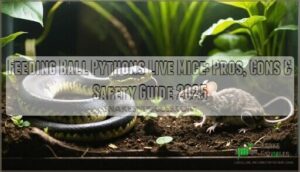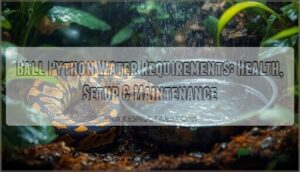This site is supported by our readers. We may earn a commission, at no cost to you, if you purchase through links.

Live prey can injure your snake with bites and scratches, while also introducing parasites and diseases.
Most experienced keepers prefer frozen-thawed mice because they’re safer, more convenient, and equally nutritious.
Your snake won’t miss out on proper nutrition with pre-killed food.
However, some finicky eaters respond better to live prey’s movement and scent.
If you choose live feeding, supervise closely and remove uneaten mice immediately.
The key is weighing your snake’s specific needs against potential dangers.
Smart feeding decisions require understanding the complete picture of safety, nutrition, and practical considerations.
Table Of Contents
- Key Takeaways
- Feeding Ball Pythons Live Mice: Pros and Cons
- Nutritional Value of Live Mice for Ball Pythons
- Potential Risks of Disease From Live Mice
- Risk of Injury From Live Mice Vs. Frozen-Thawed
- Convenience of Frozen Vs. Live Rodents for Feeding
- Cost-Effectiveness of Live Mice Vs. Frozen-Thawed
- Impact on Snake Stimulation: Live Vs. Frozen Food
- Transitioning to Frozen Food: Tips and Strategies
- Seeking Professional Advice for Ball Python Feeding
- Frequently Asked Questions (FAQs)
- Should I feed my ball python live mice?
- Can I feed my ball python wild mice?
- How to feed ball python a mouse?
- How many mice do ball pythons eat a day?
- How do you humanely euthanize mice for snake feeding?
- Can ball pythons become addicted to live prey?
- Are there legal restrictions on feeding live mice?
- How do you safely handle live mice during feeding?
- Can ball pythons distinguish between different mouse breeds?
- How often should I feed live mice?
- Conclusion
Key Takeaways
- Live mice pose serious injury risks – Your snake can suffer bites, scratches, and infections from defensive prey, while frozen-thawed mice eliminate these dangers completely without sacrificing nutrition.
- Frozen mice offer superior convenience and cost savings – You’ll save money through bulk purchasing, avoid ongoing housing costs for live prey, and reduce potential veterinary bills from snake injuries.
- Disease transmission is a major concern with live prey – Wild or poorly-sourced mice carry parasites, bacteria, and other pathogens that can seriously harm your python’s health.
- You can successfully transition reluctant feeders to frozen prey – Use scenting techniques, proper temperature warming (100-105°F), and gradual switching methods to help your snake accept safer frozen alternatives.
Feeding Ball Pythons Live Mice: Pros and Cons
Several ball python owners face a tough choice regarding ball python feeding: live mice or frozen alternatives. Live mice feeding offers distinct advantages that mirror your snake’s natural behavior in the wild.
The hunting stimulation from live prey can encourage reluctant feeders to eat and provides mental enrichment that frozen meals simply can’t match.
However, live prey comes with serious drawbacks you can’t ignore. Injury prevention becomes your top concern since mice can bite, scratch, or seriously wound your python during feeding. Ethical concerns also arise when considering the stress and suffering of live prey animals.
Prey availability can become problematic too – live mice require more planning and aren’t always accessible when you need them.
Feeding snakes live prey also presents storage challenges and potential dangers like disease transmission. As an alternative, many breeders use frozen mice effectively.
Weighing these pros and cons carefully helps you make the best decision for your python’s health and wellbeing.
Nutritional Value of Live Mice for Ball Pythons
Looking at the nutritional facts, live mice pack serious nutritional punch for your ball python.
Live mice deliver complete nutrition that perfectly matches what your python craves in the wild.
These rodents deliver a complete nutrition profile that mirrors what pythons hunt in the wild.
Key Nutritional Benefits:
- Live nutrient retention – Fresh mice contain 54-60% protein and 25-30% fat, supporting muscle development and energy needs
- Optimal calcium-to-phosphorus ratio (1.5:1 to 2:1) prevents metabolic bone disease
- Essential vitamins including A, B-complex, D, and E boost immune function
- Trace minerals like zinc, iron, and magnesium support overall health
Gut loading mice enhances their nutritional value further.
It’s important to select a mouse size based on the snake’s width, and hopper mice are often a good choice for young, growing snakes.
This wild diet comparison shows live prey offers excellent digestion efficiency.
However, frozen-thawed rodents match these benefits when properly handled, making nutrition less about alive versus dead and more about consistent, appropriately-sized meals for your python.
Potential Risks of Disease From Live Mice
You might feed your ball python the perfect-sized mouse, but live mice carry hidden dangers.
Disease transmission poses serious health risks to your snake. Wild mice bring the biggest safety hazards, harboring parasites and bacteria that frozen prey can’t transmit.
As snakes get older, they require less frequent feeding, with larger ball pythons eating only once every week or two.
Here’s what threatens your python’s health:
| Disease Type | Common Sources | Risk Level |
|---|---|---|
| Parasites | Wild rodents, poor housing | High |
| Salmonella | Contaminated bedding, handling | Medium |
| Bacterial infections | Bite wounds, stress | Medium |
| Zoonotic concerns | Direct contact, cross-contamination | Low-Medium |
| Viral diseases | Overcrowded facilities | Low |
Reputable breeders reduce these risks substantially.
Parasite transmission drops when you source from clean facilities.
Bacterial infections still occur, but proper handling minimizes exposure.
Risk of Injury From Live Mice Vs. Frozen-Thawed
Live prey brings real danger to your ball python.
Your snake’s safety matters more than recreating wild hunting experiences.
Live mice fight back with teeth and claws, creating defensive wounds that can turn serious fast.
Your snake lacks wild instincts for bite prevention, making injuries more likely.
| Live Mice Risks | Frozen-Thawed Safety |
|---|---|
| Bites cause infections | Zero retaliation risk |
| Supervision needed always | Safe, stress-free feeding |
| Ethical concerns arise | Humane euthanasia methods |
Handling techniques help with live prey, but frozen rodents eliminate injury risk completely.
Smart keepers choose frozen thawed mice over gambling with their snake’s health.
Disease transmission risks are also substantially reduced when feeding frozen prey.
Convenience of Frozen Vs. Live Rodents for Feeding
Beyond injury concerns, convenience plays a major role in your feeding decisions.
Storage needs differ dramatically between options. Live mice require temporary housing, fresh water, and regular care before feeding time. Frozen rodents sit in your freezer for months without attention.
| Factor | Live Mice | Frozen Rodents |
|---|---|---|
| Storage Needs | Temporary housing required | Long-term freezer storage |
| Preparation Time | Minimal setup needed | Thawing and warming required |
| Sourcing Ease | Regular pet store trips | Bulk online ordering |
Preparation time varies too. Live prey needs minimal setup, while frozen mice require thawing and warming. However, sourcing ease favors frozen options through bulk purchases.
Reduced disease risk is another significant benefit of frozen prey. Owner stress decreases with frozen rodents, eliminating ethical concerns about live feeding supervision.
Cost-Effectiveness of Live Mice Vs. Frozen-Thawed
Beyond convenience factors, your wallet will thank you for understanding the real cost-effectiveness between live mice and frozen options.
Live mice appear cheaper upfront, but don’t let initial prices fool you. Bulk buying benefits make frozen mice the clear winner for long-term savings.
Here’s the financial breakdown:
| Cost Factor | Live Mice | Frozen Mice |
|---|---|---|
| Initial Price | Lower per unit | Higher per unit |
| Bulk Purchases | Limited options | Significant discounts |
| Storage Space Costs | Ongoing housing needs | One-time freezer space |
| Veterinary Bill Impact | Higher injury risk | Minimal risk |
Breeding cost analysis reveals live colonies require continuous investments in food, bedding, and healthcare.
Meanwhile, frozen options eliminate these recurring expenses entirely.
You’ll also avoid potential vet bills from snake injuries – live mice can bite and scratch your python during feeding.
One should also consider disease transmission risks associated with live prey.
Smart snake owners recognize that frozen mice deliver superior long-term savings despite higher upfront costs.
Ethical concerns aside, your budget benefits from this safer, more economical choice.
Impact on Snake Stimulation: Live Vs. Frozen Food
When feeding your ball python, snake stimulation becomes a key factor in their overall well-being.
Live mice trigger natural hunting behaviors that frozen prey simply can’t match. Your snake will stalk, strike, and constrict – engaging their natural instincts fully. This sensory enrichment boosts mental wellbeing and increases activity levels substantially.
Nutritional needs are met by both options.
| Live Prey Benefits | Frozen Prey Limitations |
|---|---|
| Triggers hunting behavior | Limited movement simulation |
| Enhances mental stimulation | Reduced predatory response |
| Increases physical activity | Less behavioral enrichment |
However, ethical concerns about prey welfare must balance against your snake’s natural instincts.
Transitioning to Frozen Food: Tips and Strategies
Making the switch from live prey to frozen mice doesn’t have to feel like wrestling a stubborn snake. Your ball python can learn to accept frozen food with the right approach and feeding techniques.
Scenting Frozen Prey works like magic. Rub the thawed mouse with bedding from live rodents or use commercial scenting products. This tricks your snake’s senses into thinking it’s hunting fresh prey.
Temperature Adjustment matters more than you think. Heat the mouse to 100-105°F using warm water. A cold meal won’t trigger your python’s feeding response.
Gradual Switching Methods prevent stress. Start by offering pre-killed fresh mice, then move to frozen options. Some keepers alternate between live and frozen during the switch.
- Patience and Persistence will be your best friends—expect your snake to refuse meals initially, but don’t give up after one or two attempts.
Use feeding tongs to wiggle the prey, mimicking live movement. Safe thawing requires cold water methods to prevent bacterial growth. This simple trick often solves Feeding Response Issues when switching to frozen food.
Seeking Professional Advice for Ball Python Feeding
When you’re traversing the complex world of ball python nutrition, professional guidance can make all the difference.
Don’t fly solo on feeding decisions that impact your snake’s health. Force feeding may be required if a snake experiences significant weight loss.
| Professional | Expertise | When to Consult |
|---|---|---|
| Reptile Veterinarian | Health assessments, veterinarian consultation for illness | Feeding refusal, weight loss, digestive issues |
| Herpetologist | Species behavior, expert observation techniques | Live prey concerns, natural feeding patterns |
| Experienced Breeder | Practical feeding methods, breeder recommendations | Diet transitions, feeding schedules, animal welfare |
Getting herpetologist insights and dietitian expertise guarantees you’re making informed choices about live prey versus frozen options.
Frequently Asked Questions (FAQs)
Should I feed my ball python live mice?
Walking on thin ice with live mice isn’t recommended.
You’ll face injury risks to your snake from bites and scratches.
Frozen-thawed prey provides identical nutrition while eliminating dangers, making it the safer choice.
Can I feed my ball python wild mice?
You shouldn’t feed your ball python wild mice.
Wild rodents carry parasites, diseases, and bacteria that can seriously harm your snake.
They’re also unpredictable and aggressive, creating unnecessary risks during feeding.
How to feed ball python a mouse?
Like threading a needle, precision matters when feeding your ball python.
Use feeding tongs to offer pre-killed, warmed prey inside the enclosure.
Don’t handle your snake for 48 hours afterward to guarantee proper digestion.
How many mice do ball pythons eat a day?
Ball pythons don’t eat daily. You’ll feed juveniles every 5-7 days, subadults every 10-14 days, and adults every 2-3 weeks. They typically consume one appropriately-sized mouse per feeding session.
How do you humanely euthanize mice for snake feeding?
Necessity is the mother of invention" rings true here.
You’ll use cervical dislocation—firmly grasp the head and body, then quickly separate with a sharp pull.
This method’s instant and humane when done correctly.
Can ball pythons become addicted to live prey?
While ball pythons can develop preferences for live prey, they don’t become "addicted" in the clinical sense.
However, they may refuse frozen-thawed food after consistent live feeding, making dietary shifts challenging.
Are there legal restrictions on feeding live mice?
Most places don’t have specific laws against feeding live mice to snakes.
However, you’ll need to check your local animal welfare regulations, as some areas restrict live feeding practices for reptiles.
How do you safely handle live mice during feeding?
Use feeding tongs to grasp mice securely behind the head.
Never handle with bare hands to avoid bites.
Move slowly and deliberately.
Keep the mouse calm by minimizing stress before offering to your snake. Never handle
Can ball pythons distinguish between different mouse breeds?
Like a sommelier detecting wine notes, your ball python can distinguish between different mouse breeds through scent and taste.
They’ll notice variations in fat content, size, and flavor profiles between breeds like feeder mice versus fancy varieties, which can be a key factor in their preference.
How often should I feed live mice?
Feed hatchlings live mice every 5-7 days, juveniles every 10-14 days, and adults every 2-3 weeks.
You’ll adjust frequency based on your snake’s age, weight, and digestion rate for ideal health.
Conclusion
Ultimately, feeding ball pythons live mice remains a personal choice that demands careful consideration.
You’ve learned the risks, benefits, and safety measures involved in this feeding method.
Whether you choose live or frozen-thawed prey, your snake’s health and safety should guide every decision.
Monitor your python’s response, maintain proper supervision, and don’t hesitate to consult reptile veterinarians when questions arise.
Smart feeding practices guarantee your ball python thrives for years to come.
- https://showmereptileshow.com/resources/-feeding-live-vs-frozen-rodents-to-snakes-exploring-the-pros-and-cons
- https://www.youtube.com/watch?v=NAASQnP7Xxk
- https://www.reddit.com/r/ballpython/comments/1dc6e3e/legal_or_illegal_to_feed_live_mice/
- https://www.nwreptiles.com/feeders-for-your-ball-pythons/
- https://reptifiles.com/ball-python-care-guide/ball-python-feeding/












